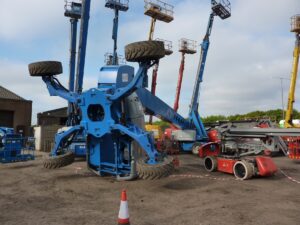Carlsberg has been fined £3 million after a contractor died and another was seriously injured following an ammonia gas leak at one of its breweries.
The incident happened at Carlsberg’s site in Northampton. An investigation by the Health and Safety Executive (HSE) found Carlsberg hadn’t put proper controls in place.
Father-of-two David Chandler, 45, was killed and David Beak, now 57, was seriously injured.
David Chandler was a father of two, from Bridge North, Shropshire. His family today said they welcomed the end of the case against Carlsberg and hoped no other families would have to suffer as they have.
Birmingham Crown Court heard that at its Northampton brewery Carlsberg had failed to put in place appropriate isolation controls to prevent exposure to ammonia before work started to remove a compressor from a refrigeration system.
The Principal Contractor for the project was Crowley Carbon UK Ltd, which had appointed numerous contractors to assist in the works.
On 9 November 2016 while the compressor was being removed, there was a large, uncontrolled release of ammonia.
David Chandler and David Beak were both employees of sub-contractor Speedrite NE Ltd.
Twenty people needed hospital checks after showing symptoms of ammonia exposure. It was several days before the leak was contained and gas levels dropped to a safe level. David Beak, of Failsworth in Oldham, was seriously injured.
Carlsberg Supply Company UK Ltd, who were summonsed under their new company name of Carlsberg Marston’s Brewing Company, pleaded guilty to charges under Section 2(1) and Section 3(1) of the Health and Safety at Work etc. Act 1974, and Regulation 3(1) of the Management of Health and Safety at Work Regulations 1999. The company was fined £3 million with costs of £90,000.
Mr Chandler’s family, in a statement, said: “We welcome the conclusion of the prosecution case against Carlsberg UK Supply Company Ltd following the death of David five and half years ago.
“As a family we will never fully accept the death of David in such tragic but preventable circumstances and the legal process involved has been emotionally exhausting as well as frustrating given the length of time which has lapsed since the accident.
“We are pleased that improvements have been made at Carlsberg’s site in Northampton which will hopefully ensure no other families suffer the anguish we have endured since November 2016 when the failings at the brewery resulted in the deadly release of ammonia gas which caused David’s death.
“David was a loving husband, adoring Daddy and much-loved brother and Uncle. We are devastated that his young family will not be able to share their lives with him as they grow. He was a larger-than-life character whose loss has left a massive void nothing can replace.
“There have already been so many special and precious moments which David has missed out on and the fact that there will continue to be some many more as his daughters grow into young ladies breaks all our hearts daily. He is missed every day, and our lives will not ever be the same without him.”
HSE principal inspector Samantha Wells said: “Industry guidance on safe isolation of plant should have been followed. This would have ensured that a higher level of isolation was in place, for prevention of exposure to this highly toxic and flammable substance.
“Both the client, Carlsberg, and the Principal Contractor should have worked together to ensure that the risk was adequately managed. Not only Carlsberg had a duty here. There was also a very clear duty on the Principal Contractor.
“This underlines the dangers of not following industry guidance when working with toxic and flammable substances – HSE will take action against all who fail to ensure the safety of employees and others who may be exposed to danger.
“Projects involving multiple contractors require effective management arrangements, so it’s clear who is responsible for every part of the work and that safety checks are carried out before allowing work to start.”
The Health and Safety Executive also brought a case against Crowley Carbon Ltd in relation to the incident which led to the death of Mr Chandler and the injuries to Mr Beak, which were also due to be tried but for the company being placed into compulsory administration by creditors.
Notes to editors:
- The Health and Safety Executive (HSE) is Britain’s national regulator for workplace health and safety. We prevent work-related death, injury and ill health through regulatory actions that range from influencing behaviours across whole industry sectors through to targeted interventions on individual businesses. These activities are supported by globally recognised scientific expertise. www.hse.gov.uk
- More about the legislation referred to in this case can be found at: www.legislation.gov.uk/
- HSE news releases are available at: http://press.hse.gov.uk
- Further guidance on the safe isolation of plant and equipment can be found at: The safe isolation of plant and equipment – HSG253 (hse.gov.uk)
 urt heard that Rick Jeager-Fozard, an employee of Kimberly Access Limited, was carrying out a routine pre-delivery inspection on a mobile elevating work platform (MEWP) on 5 June 2013.
urt heard that Rick Jeager-Fozard, an employee of Kimberly Access Limited, was carrying out a routine pre-delivery inspection on a mobile elevating work platform (MEWP) on 5 June 2013.